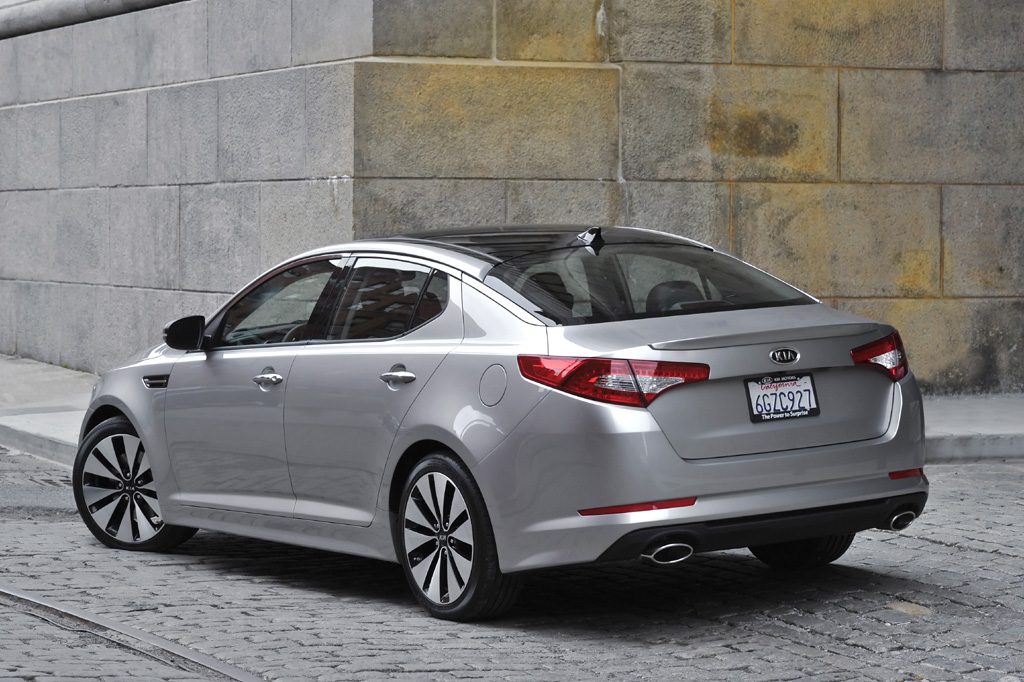| Midsize car; Built in USA |
|
|
| Good condition price range: $8,000 – $23,200* |

2011 Kia Optima Front

2011 Kia Optima Rear

2011 Kia Optima Interior

2011 Kia Optima

2011 Kia Optima Front-2
| Pros: |
|
| Cons: |
|
The redesigned Kia Optima aimed to deliver upscale accouterments and a sporty, driver-oriented demeanor at bargain prices, and it mostly succeeds. Optima isn’t quite as dynamically polished as midsize-sedan leaders. That’s true of the sporty SX model as well, which we believe makes too many compromises in ride quality and quietness, even though it handles better and accelerates more strongly than other Optimas. Overall, the latest Optima’s expressive styling, good fuel economy, and generous list of standard and optional equipment make the LX and EX 2.4 Best Buys (2011-12). Aggressive pricing when new is likely to translate to appealing deals for a used Optima.
Overview
Kia redesigned its Optima sedan for 2011, not only giving it freshened styling but adding a new gas/electric hybrid model. This midsize car shared elements of its basic design and powertrains with the also-redesigned 2011 Hyundai Sonata, produced by Kia’s corporate parent. Optima reprised its LX, EX, and SX trim levels, along with the new Hybrid model. LX and EX sedans had a 200-horsepower, 2.4-liter four-cylinder engine. That engine replaced both a 175-horsepower, 2.4-liter four-cylinder and a 194-horsepower, 2.7-liter V6. Standard on SX and available on EX was a 274-horsepower, 2.0-liter turbocharged four-cylinder engine. So, all Optimas now had four-cylinder power. A six-speed manual transmission was available only on the LX sedan. A six-speed automatic was optional for that model, and standard otherwise. The Hybrid used a 2.4-liter four-cylinder engine and a battery-powered electric motor for 206 horsepower total, connected to a six-speed automatic transmission. The Hybrid could run on one or both its power sources, to balance acceleration and fuel economy. Standard safety features included all-disc antilock braking, traction control, an antiskid system, front side airbags, and curtain side airbags. Available features included heated and cooled front seats, heated rear seats, a wireless cell-phone link, air-conditioned glovebox, panoramic sunroof, and a navigation system. Optima competitors included the midsize Ford Fusion, Honda Accord, and Toyota Camry, as well as the Chevrolet Malibu, Chrysler 200, Mazda 6, and Nissan Altima.
Yearly Updates
| 2012 Optima Production of the 2012 Kia Optima moved from South Korea to the U.S., and the sedan added a few features. Kia’s UVO entertainment system was newly optional in EX, SX, and hybrid models (but not available in cars with a navigation system). |
| 2013 Optima For 2013, feature and option availability was largely unchanged, but leather upholstery was no longer standard on the sporty SX variant. |
| 2014 Optima The Kia Optima got a few new features for 2014. On the outside, Optima received redesigned front and rear bumpers, air diffuser detailing on the bottom of the rear bumper, a strip of LEDs mounted along the top of the headlights, LED fog lights, and LED taillights. Inside, a new, color LCD screen sat between the speedometer and tachometer in the instrument cluster. Newly available was an 8-inch touchscreen in the middle of the dash that governed the audio and infotainment functions. Also new were the seats, and blind-spot alert, rear cross-traffic detection, and rear-obstacle detection were available for the first time. The Optima SX got a feature that adjusts transmission shift points and steering weight at the flick of a switch for a sportier driving feel. |
